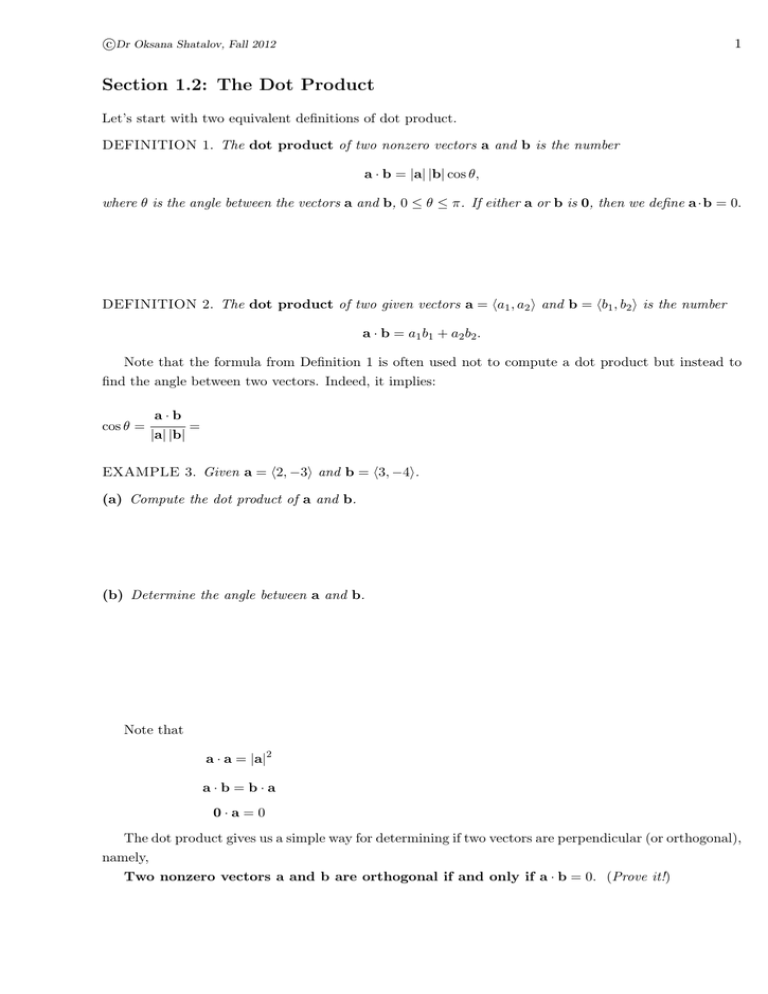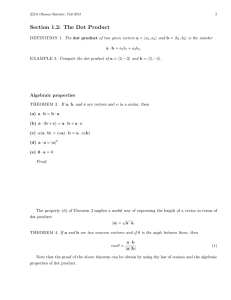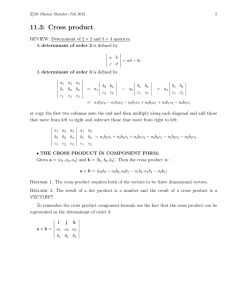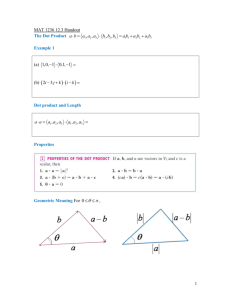Document 10581523
advertisement

c Dr Oksana Shatalov, Fall 2012 1 Section 1.2: The Dot Product Let’s start with two equivalent definitions of dot product. DEFINITION 1. The dot product of two nonzero vectors a and b is the number a · b = |a| |b| cos θ, where θ is the angle between the vectors a and b, 0 ≤ θ ≤ π. If either a or b is 0, then we define a·b = 0. DEFINITION 2. The dot product of two given vectors a = ha1 , a2 i and b = hb1 , b2 i is the number a · b = a1 b1 + a2 b2 . Note that the formula from Definition 1 is often used not to compute a dot product but instead to find the angle between two vectors. Indeed, it implies: cos θ = a·b |a| |b| = EXAMPLE 3. Given a = h2, −3i and b = h3, −4i. (a) Compute the dot product of a and b. (b) Determine the angle between a and b. Note that a · a = |a|2 a·b=b·a 0·a=0 The dot product gives us a simple way for determining if two vectors are perpendicular (or orthogonal), namely, Two nonzero vectors a and b are orthogonal if and only if a · b = 0. (Prove it!) c Dr Oksana Shatalov, Fall 2012 2 EXAMPLE 4. Determine whether the given vectors are orthogonal, parallel, or neither. (a) h3, 4i, h−8, 6i (b) h−7, −4i, h28, 16i (c) h1, 1i, h2, 3i EXAMPLE 5. What is the dot product of 12j and 11i? DEFINITION 6. The work done by a force F in moving and object from point A to point B is given by W =F·D −−→ where D = AB is the distance the object has moved (or displacement). EXAMPLE 7. Find the work done by a force of 50lb acting in the direction N 30o W in moving an object 10f t due west. c Dr Oksana Shatalov, Fall 2012 3 EXAMPLE 8. A constant force F = 25i + 4j (the magnitude of F is measured in Newtons) is used to move an object from A(1, 1) to B(5, 6). Find the work done if the distance is measured in meters DEFINITION 9. The orthogonal compliment of a = ha1 , a2 i is a⊥ = h−a2 , a1 i. Note that |a| = a⊥ and a · a⊥ = EXAMPLE 10. Given h4, −2i, h2, −1i, h−2, 1i and a = h1, 2i. Which of these vectors is • orthogonal to a? • the orthogonal compliment of a? Scalar and vector projections: For given two vectors a and b we determine the projection of b onto a. • The vector projection of b onto a is denotes by proja b and can be found by the formula proja b = a·b |a|2 a. • The scalar projection of b onto a (or the component of b along a) is denotes by compa b and can be found by the formula a·b . compa b = |a| c Dr Oksana Shatalov, Fall 2012 4 EXAMPLE 11. Given a = h4, 3i and b = h1, −1i. Find: • a·b= • |a| = • |b| = • projb a = • compa b = EXAMPLE 12. Find the distance from the point P (−2, 3) to the line y = 3x + 5. y x 0





